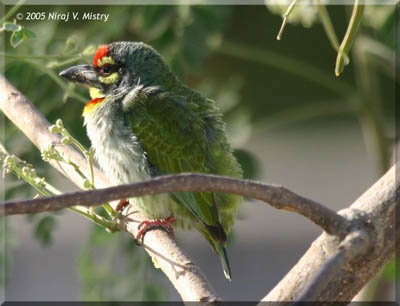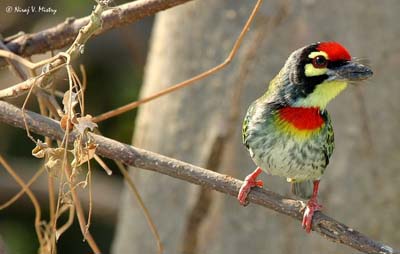
Coppersmith Barbet
Psilopogon haemacephalus
Piciforme Order – Megalaimidae Family
BIOMETRICS:
Length: 16-17 cm
Weight: 30-53 gr
DESCRIPTION:
Coppersmith Barbet is a plump bird. It has large head, and short neck and tail.
Adult has green upperparts. Underparts are mainly whitish, heavily streaked with green. Tail is short and triangular in flight.
Large head is very colourful. Forehead is red. Crown and nape are green. It has yellow patches above and below the eye. Chin and throat are yellow.
We can see a red half-collar between throat and chest, and other yellowish-green below the first. Blend black colour separates the green colour from the others on the head.
Heavy bill is black, bordered at base with conspicuous bristles. Eyes are brown, with red eye-ring. Legs and feet are pinkish-red.
Fr: Barbu à plastron rouge
All : Kupferschmied
Esp : Barbudo Calderero
Ital : Barbuto fabbro
Nd : Kopersmid baardvogel
Photographer:
Niraj V. Mistry
His website:
Photo Galleries
Text by Nicole Bouglouan
Sources:
HANDBOOK OF THE BIRDS OF THE WORLD Vol. 7 by Josep del Hoyo-Andrew Elliott-Jordi Sargatal – Lynx Edicions – ISBN: 8487334377
Wikipedia (Wikipedia, The Free Encyclopedia)
BirdLife International (BirdLife International)

Both sexes are similar, but female has duller red colours on head and breast.
Juvenile has duller plumage and lacks red patches.
VOICE: SOUNDS BY XENO-CANTO
Coppersmith Barbet’s call is a “pup” or a “tuk”, continuously repeated with regular rhythm, sometimes faster if bird is excited.
It sings while it shakes the head, and utters some notes in several directions, making its call more sonorous. It is frequently heard, and well known for its “hammering” metallic song.
HABITAT:
Coppersmith Barbet is common in deciduous forests and open woodlands, countries with thickets, urban parks and gardens with fruiting trees. It is also found in mangroves’ edges.
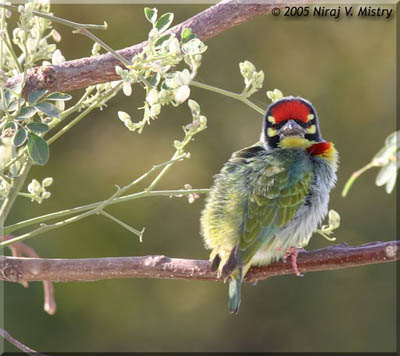
RANGE:
Coppersmith Barbet lives in India, Pakistan, Nepal, Bangladesh, and Sri Lanka to SW China, Malaysia, Sumatra and the Philippines.
BEHAVIOUR:
Coppersmith Barbet forages alone or in pair in tree canopy and on fruiting trees. It also taps and removes bark chips to reach invertebrates concealed between trunk and bark. It also forages on the underpart of leaves, at tip of small branches. It can catch insects on the wing, snatching them during heavy flight.
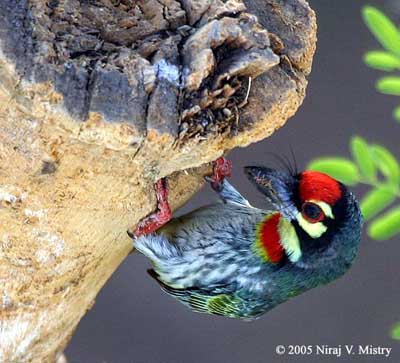
Coppersmith Barbet is seen singly or in small groups in trees. It is an arboreal species. It doesn’t migrate, but it can perform some dispersion within its range.
During courtship displays, pair may utter duets, and perform courtship feeding. We can hear more songs. The bird puffs the throat feathers, moves the head by turning and bobbing, and flicks the tail.
FLIGHT:
Coppersmith Barbet is a stocky-bodied bird which performs a direct finch-like flight.
REPRODUCTION:
Breeding season varies according to the range.
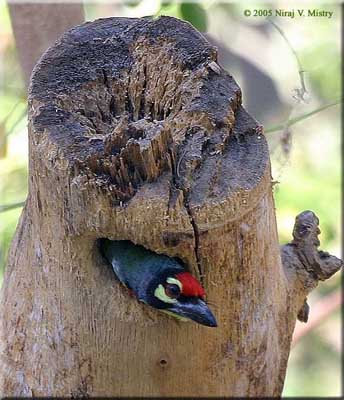
Coppersmith Barbet nests in holes. Female excavates in soft or dead wood, in trunk or branch of tree.
She prepares the hole in September-October, but breeding season starts only in February-March. Both sexes may modify and clear the nest cavity during this period. Cavity is situated at about 1,50 m to 15 metres above the ground. It is relatively deep, about 15 to 80 cm. Entrance may size 4 to 5 cm.
Coppersmith Barbet can reuse the same hole with some extension or new entrance, but new nest may be built each year.
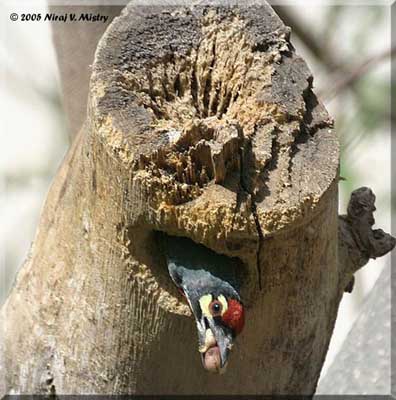
Female lays 2 to 4 white, glossless eggs. Incubation lasts about two weeks, shared by both parents. Altricial chicks are brooded and fed by both adults.
Young fledge at about 35 days of age. Parental care stops at fledging.
DIET:
Coppersmith Barbet feeds mainly on wide variety of fruits such as figs, berries and mangoes, but it also consumes insects such as beetles, mantis and crickets.
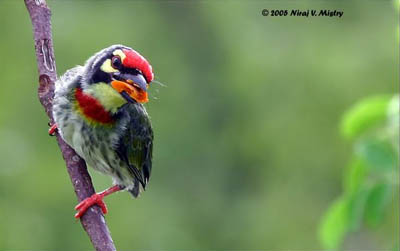
PROTECTION / THREATS / STATUS:
Coppersmith Barbet populations are not threatened. This species is very common in most parts of its range.
This species is able to live in urban areas, and adapts fairly well to changes in its habitat.
